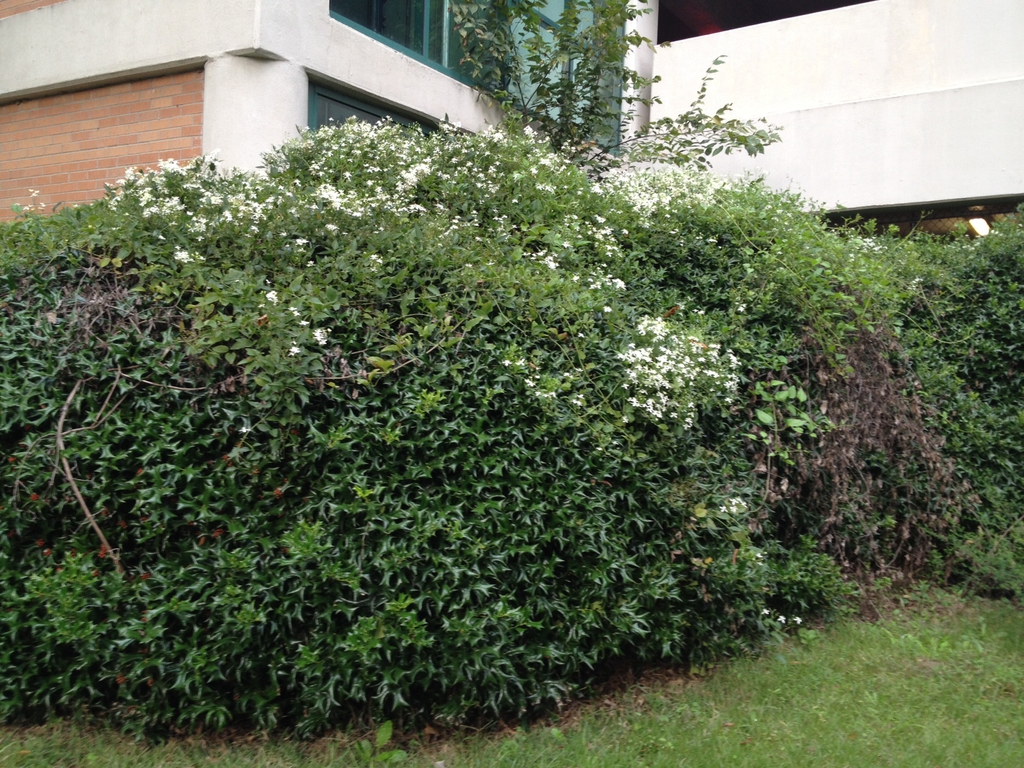Sweet Autumn Clematis Clematis paniculata
Other Common Name(s):
Other plants called Sweet Autumn Clematis:
Previously known as:
- Clematis indivisa
- Clematis maximonowicziana
- Phonetic Spelling
- KLEM-ah-tiss pan-ik-yoo-LAY-tah
- This plant has high severity poison characteristics.
- See below
- Description
-
Sweet autumn clematis is an aggressive, woody, perennial vine in the Ranunculaceae (buttercup) family and native to New Zealand. It grows rapidly in addition to self-seeding and is considered invasive in some states surrounding North Carolina.
It grows in full sun, dappled sunlight, or partial shade in moist soils with good drainage. This plant flowers only on new wood and can be cut to the ground in fall or spring.
The pinwheel flowers are fragrant and white with four petal-like parts and many stamens. The seed heads are feathery in appearance. Flowers attract pollinators and songbirds use the vine as a nesting site. This plant may be less frequently damaged by deer than other clematis species.
Insects, Diseases, and Other Plant Problems: Self-seeds and grows aggressively. Consider a native alternative.
VIDEO Created by Elisabeth Meyer for "Annuals, Perennials, Vines, and Groundcovers" a plant identification course offered in partnership with Longwood Gardens.
- Profile Video:
- See this plant in the following landscape:
- Cultivars / Varieties:
-
- Tags:




















- Cultivars / Varieties:
-
- Tags:
-
-
Attributes:
- Genus:
- Clematis
- Species:
- paniculata
- Family:
- Ranunculaceae
- Life Cycle:
- Perennial
- Woody
- Recommended Propagation Strategy:
- Layering
- Seed
- Stem Cutting
- Country Or Region Of Origin:
- New Zealand
- Wildlife Value:
- This plant attracts bees, butterflies, and hummingbirds. Birds build nests inside the vine.
- Play Value:
- Wildlife Food Source
- Climbing Method:
- Twining
-
-
Whole Plant Traits:
- Plant Type:
- Perennial
- Poisonous
- Vine
- Woody Plant Leaf Characteristics:
- Deciduous
- Semi-evergreen
- Habit/Form:
- Cascading
- Climbing
- Dense
- Spreading
- Growth Rate:
- Rapid
- Maintenance:
- High
- Medium
- Texture:
- Medium
-
-
Cultural Conditions:
- Light:
- Dappled Sunlight (Shade through upper canopy all day)
- Full sun (6 or more hours of direct sunlight a day)
- Partial Shade (Direct sunlight only part of the day, 2-6 hours)
- Soil Texture:
- Clay
- Loam (Silt)
- Sand
- Soil Drainage:
- Good Drainage
- Moist
- Available Space To Plant:
- 3 feet-6 feet
- NC Region:
- Coastal
- Mountains
- Piedmont
- USDA Plant Hardiness Zone:
- 3a, 3b, 4a, 4b, 5a, 5b, 6a, 6b, 7a, 7b, 8a, 8b
-
-
Fruit:
- Fruit Color:
- Brown/Copper
- Fruit Value To Gardener:
- Showy
- Display/Harvest Time:
- Fall
- Fruit Type:
- Achene
- Fruit Description:
- Plume-like seed heads.
-
-
Flowers:
- Flower Color:
- Gold/Yellow
- White
- Flower Inflorescence:
- Panicle
- Flower Value To Gardener:
- Fragrant
- Long Bloom Season
- Showy
- Flower Bloom Time:
- Fall
- Summer
- Flower Shape:
- Cross
- Star
- Flower Petals:
- 4-5 petals/rays
- Bracts
- Flower Size:
- 1-3 inches
- Flower Description:
- 1-inch white fragrant pinwheel flowers with 4 bracts that are petal-like and have many yellowish stamens.
-
-
Leaves:
- Woody Plant Leaf Characteristics:
- Deciduous
- Semi-evergreen
- Leaf Color:
- Green
- Leaf Feel:
- Glossy
- Leathery
- Leaf Type:
- Compound (Pinnately , Bipinnately, Palmately)
- Leaf Arrangement:
- Alternate
- Opposite
- Leaf Shape:
- Elliptical
- Ovate
- Leaf Margin:
- Entire
- Hairs Present:
- No
- Leaf Description:
- The 3-5 leaflets per stem are green, shiny and leathery textured.
-
-
Stem:
- Stem Is Aromatic:
- No
-
-
Landscape:
- Attracts:
- Bees
- Butterflies
- Hummingbirds
- Songbirds
- Resistance To Challenges:
- Deer
- Problems:
- Contact Dermatitis
- Problem for Cats
- Problem for Children
- Problem for Dogs
- Problem for Horses
- Weedy
-
-
Poisonous to Humans:
- Poison Severity:
- High
- Poison Symptoms:
- Clematis can cause severe mouth pain and ulcers if eaten. Toxic to dogs, cats, horses. Clinical signs are salivation, vomiting, diarrhea. In humans, symptoms may include dizziness, confusion, fainting, and convulsions. Fatalities are rare, due to the rapid and intense bitter taste and mouth irritation from eating. Gastric lavage is recommended and anti-inflammatory to soothe irritated tissue. Contact dermatitis results in skin redness and burning sensation for some people, gardening gloves are recommended.
- Poison Toxic Principle:
- protoanemonin
- Causes Contact Dermatitis:
- Yes
- Poison Part:
- Leaves
- Sap/Juice














